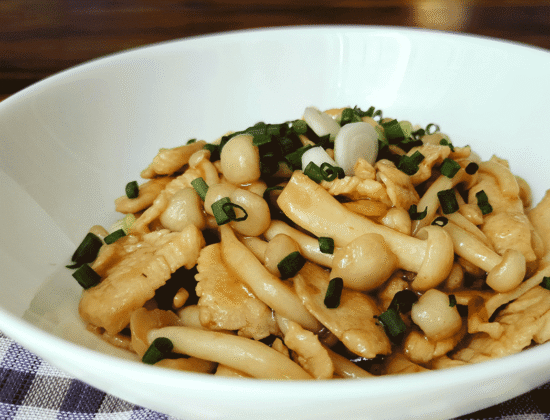If you’ve ever wondered why the chicken in your favorite Chinese stir-fry is so tender, while your home-cooked version turns out a little dry or chewy, the secret is probably velveting. It’s a common technique used in Chinese restaurants but rarely done in home kitchens, even though it’s simple, fast, and uses basic ingredients.
Velveting gives meat a soft, silky texture that holds up well during high-heat cooking, such as stir-frying. It’s handy for lean meats like chicken breast or flank steak, which can dry out quickly if not handled properly.
This post explains what velveting is, why it works, how to do it at home, and when it’s most useful. We’ll also explore various velveting methods, the science behind baking soda, and some dishes where it can be put to good use.
What Is Velveting?
Velveting is a pre-cooking step that tenderizes meat and helps it stay juicy when cooked over high heat. In Chinese restaurant kitchens, it’s used daily, especially for dishes like kung pao chicken, beef with broccoli, and chicken and cashew stir-fry.
There are two main types of velveting:
- Baking soda velveting, where meat is tossed in baking soda and left to rest for a short time, then rinsed and cooked.
- Cornstarch marinade velveting, where sliced meat is coated in a mixture of cornstarch, oil, soy sauce, and sometimes wine, then either blanched in water or briefly passed through oil.
Both methods create a protective barrier around the meat, keeping it from becoming tough or rubbery when cooked quickly at high heat.
Why Use Velveting?
Velveting is the main reason restaurant stir-fry dishes feel so different from home versions. Lean cuts, such as chicken breast, are prone to drying out. Velveting helps the meat retain moisture and improves the texture so each bite is juicy and tender.
It also helps the meat cook more evenly and gives it a surface that clings better to sauces. In fact, I’ve found that meat browns better and makes a better fond after it has been velveted.
Once you learn to velvet, your home stir-fries will start to taste like they came from your favorite takeout spot.
Method 1: Baking Soda Velveting (Quick and Easy)
This is the simplest way to velvet meat. It’s great for chicken breast, beef, or pork.
Ingredients:
- 1 pound of thinly sliced meat
- 3/4 teaspoon of baking soda for chicken or pork
- 1 teaspoon of baking soda for beef
Instructions:
- Slice the meat into thin strips across the grain.
- Toss it with baking soda in a bowl so it’s evenly coated.
- Let it sit at room temperature for 15 to 20 minutes.
- Rinse thoroughly under cold running water to remove the baking soda.
- Pat dry with paper towels.
The meat is now ready to cook. You can toss it in a sauce or marinate it before stir-frying.
Method 2: Cornstarch Marinade Velveting (More Traditional)
This version is often used in Cantonese cooking and produces silky, slightly glossy meat. It takes a little longer but gives great results.
Ingredients:
- 1 pound of thinly sliced meat
- 1 tablespoon cornstarch
- 1 tablespoon soy sauce
- 1 tablespoon oil (vegetable, canola, or peanut)
- Optional: 1 tablespoon Shaoxing wine or dry sherry
Instructions:
- Slice the meat thinly.
- Mix all marinade ingredients in a bowl.
- Toss in the meat and stir to coat evenly.
- Let it sit for 20 to 30 minutes.
- Blanch or pre-cook the meat:
- In simmering water for 30 to 60 seconds until just turning white.
- Or in oil heated to 275–300°F for about 30 seconds. This is not deep-frying, just a gentle pre-cook.
Remove and drain. Now it’s ready to add to your stir-fry or noodle dish.
Why Baking Soda Works: The Science
Baking soda, or sodium bicarbonate, raises the pH on the surface of the meat. This reduces how quickly proteins bond together when exposed to heat. When proteins bond too tightly, they squeeze out moisture, creating a tough texture. Baking soda keeps them relaxed, so the meat stays tender and juicy.
It only takes a small amount and a short time. Too much or too long and the meat can turn mushy or spongy, which no one wants. That’s why it’s important to measure carefully and rinse thoroughly.
Western Tenderizing Methods vs. Velveting
In Western kitchens, people tenderize meat using techniques such as pounding with a mallet, marinating in acids (like vinegar or lemon juice), or using commercial meat tenderizers that contain enzymes like papain or bromelain.
These work, but they often change the flavor of the meat. Velveting, especially with baking soda, leaves no noticeable taste when done right. And it keeps the meat closer to its natural texture—just better.
You could say Western methods often change the flavor to improve the texture, while velveting protects the texture without changing the flavor much.
Other Proteins You Can Velvet
While chicken breast is the most common, you can velvet:
- Beef: Flank steak, sirloin, or skirt steak. Use a slightly higher amount of baking soda and let it sit up to 30 minutes.
- Pork: Pork loin or tenderloin works well. Same amount and time as chicken.
- Shrimp: Use the cornstarch version. Don’t use baking soda; it can mess with the texture.
- Tofu: Firm tofu can be coated in cornstarch and lightly fried or boiled for a velvety effect. It’s not traditional, but it works.
- Fish: Some chefs velvet firm fish like cod or halibut using the cornstarch method for delicate stir-fries.
Can You Velvet Vegetables?
Not exactly. But blanching vegetables like broccoli, snow peas, or bok choy briefly before stir-frying gives a similar benefit. It preserves color, keeps texture snappy, and prevents overcooking.
You can also toss them in a bit of oil and cornstarch before stir-frying for a glossy finish that mimics velveted meat.
What Happens If You Skip It?
Nothing terrible, but your dish won’t have that silky, restaurant-style bite. The meat may turn out a bit dry, especially if you use high heat or very lean cuts. Once you try velveting, you’ll probably start doing it regularly. It’s a small step that gives big results.
Recipes to Try After Velveting
Once you’ve velveted your meat, use it in:
- Chicken and Broccoli Stir-Fry: Toss velveted chicken into a hot wok with garlic, ginger, broccoli, and a light soy sauce glaze.
- Beef with Snow Peas: Velveted flank steak stir-fried quickly with snow peas and a touch of oyster sauce.
- Cashew Chicken: Velveted chicken with bell peppers, onions, and toasted cashews in a sweet-savory sauce.
- Shrimp Lo Mein: Use the cornstarch version on shrimp, then mix with noodles and veggies for a quick meal.
These dishes will now taste closer to what you’d get at a good restaurant.
Tips for Success
- Don’t skip rinsing if you use baking soda. It won’t taste good otherwise.
- Slice the meat thin and even for best texture and cooking speed.
- Don’t overcook velveted meat. It’s already tender, so a few minutes is enough.
- Practice once or twice. Then it becomes automatic.
- Don’t stop at just Chinese food; I recently used this technique when making Beef Kapow with excellent results.
Final Thoughts
Velveting isn’t complicated, expensive, or time-consuming. But it makes a huge difference in the texture and flavor of your stir-fry dishes. It’s one of those simple restaurant secrets that’s easy to bring home.
Whether you use the baking soda method or the cornstarch marinade, you’ll notice the change right away. That soft, silky bite is no longer just for takeout nights. You can make it in your own kitchen tonight.
Give it a try and see. Your stir-fry game just leveled up.



